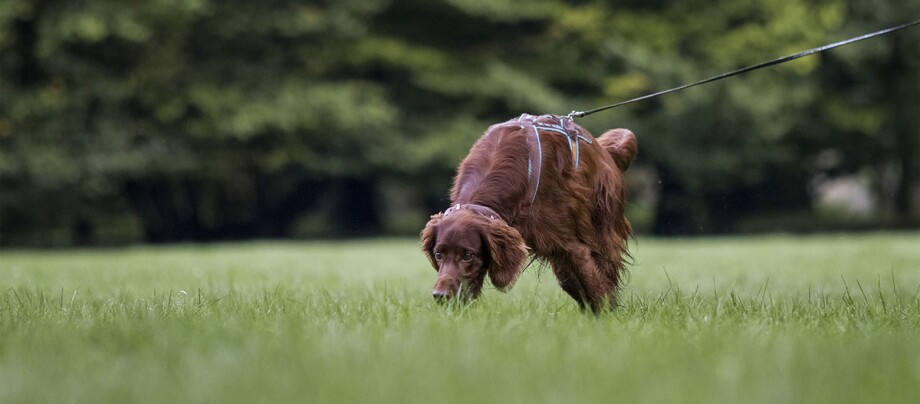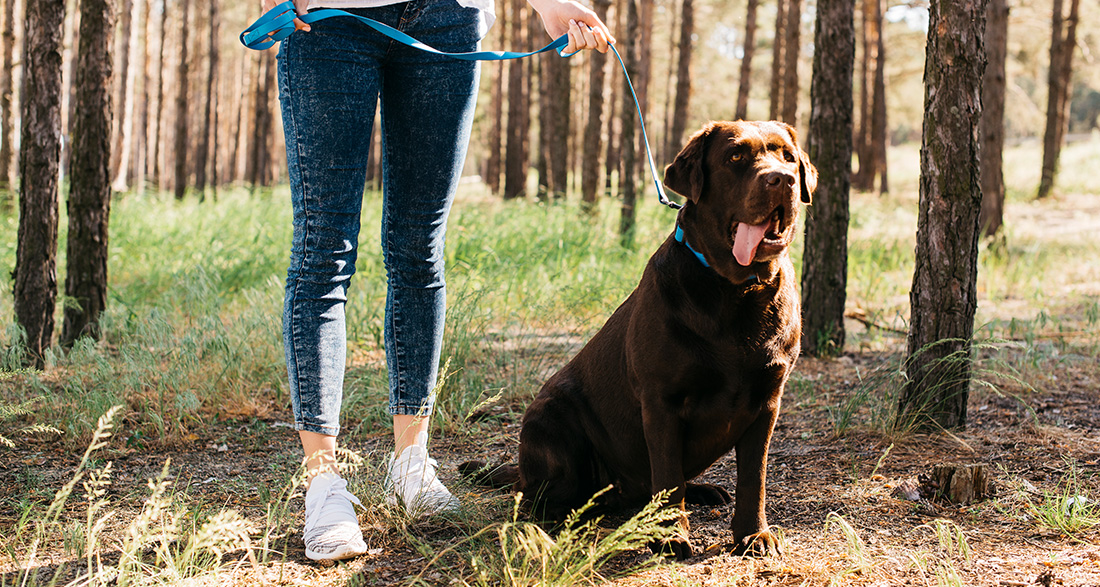There are many ways to engage our dogs in a way that’s appropriate for their nature. One of these ways is mantrailing – the search for a person based on their individual scent. For which dogs is mantrailing suitable? How can training be structured? This specialized article reveals more to you!
- Mantrailing Today – as a Profession or as a Hobby
- Mantrailing – How Does It Work?
- What is an Individual Scent?
- What Makes the Dog’s Sense of Smell So Special?
- How Is a Dog Trained to Be a Mantrailer?
- Adhering to Rituals is Very Important
- Why is Mantrailing Such a Great Activity?
- Mantrailing for Insecure or Fearful Dogs
- Mantrailing for Dogs with Physical Handicaps
- Mantrailing – Can My Dog Do It Too?
Mantrailing originally comes from the USA, where Bloodhounds were primarily used for it at the time. The English term “mantrailing” is composed of the English words “man” = human and “trail(ing)” = to track (a trail). So, mantrailing means the search for humans. For example, because they are considered missing or because there is a search for them.
Mantrailing Today – as a Profession or as a Hobby
Today, dogs are trained as mantrailers almost worldwide – whether in the police force or, for example, in search and rescue dog teams.
A well-trained mantrailer (also called a human scent detection dog) can track a trail that is several kilometers long, 24 hours old, or depending on the weather, even older.
To reach operational readiness, a dog must pass several examination levels, which can take two to three years for the training.
However, not everyone who trains with their dog for mantrailing aims to go into action with them as a search and rescue dog.
More and more dog owners are discovering mantrailing for themselves and their four-legged partners as a hobby and ideal engagement. After all, they are out together as a team, and the human gets to learn to trust their dog’s nose.
“Once you start to discover how fascinating your dog’s nose works, you’ll never want to stop…”
Mantrailing – How Does It Work?

Mantrailing involves tracking the trail of a specific person based on a scent sample (individual scent). Examples of scent samples can be a T-shirt, a tissue, or a sock, etc. In short, anything that the sought-after person has come into direct contact with.
The scent sample is shown to the dog at the beginning of the trail or held in front of their nose. Of course, care is taken to ensure that this scent sample does not come into contact with other scents beforehand, such as with the hands of assistants.
Once the dog has taken in the desired individual scent, they begin to follow the human trail. They are guided by their human/partner on a five to ten-meter-long tracking line and a well-fitting harness.
Well-trained human scent detection dogs are able to filter out this one specific scent among many other scents and reliably follow it. What an art, not to be distracted or confused by so many other scents!
What is an Individual Scent?
During mantrailing, the dog follows the so-called individual scent of a person. This scent is comparable to a fingerprint – individual and neither washable nor coverable.
The individual scent of a person is composed as follows:
- Through approximately 40,000 skin cells that humans lose daily (approximately 16g/day)
- Through constant excretions via the digestive and respiratory tract
- Through the daily loss of approximately 500 to 1000 ml of water through the skin, respiration, and mucous membranes
- Through metabolic products and gases (ammonia, hydrogen, carbon dioxide, phenol, methane, fatty acids, etc.) that are secreted via the decomposition of shed cellsIn addition to individual genetic factors, the environment, living conditions, and diet of the respective person also play a role.
What Makes the Dog’s Sense of Smell So Special?
Dogs belong to the so-called macrosmatics, meaning that their sense of smell is very well developed and plays a particularly large role in their lives.
For example, dogs have approximately 250 million olfactory cells, whereas humans only have approximately 5 million of these cells in comparison. The olfactory bulb, where all scent information is processed and transmitted, constitutes 10% of the dog’s brain – in contrast to only 1% in humans.
Dogs Can Use Stereoscopic Smelling
Additionally, dogs have the extraordinary ability of stereoscopic smelling. They can process scent signals from their two nostrils separately. As a result, they can locate an airborne scent, just as we humans can locate the origin of a sound without turning our heads.
Thus, the dog is capable of simultaneously recognizing from which direction the older scent and from which direction the fresher trail comes. This ability is enormously important for mantrailing.
How Is a Dog Trained to Be a Mantrailer?
As with all dog training, there are various ways to achieve the goal. As long as these methods are dog-friendly, non-violent, and logically structured, they are all acceptable. Below, we describe how we typically proceed at iHugDogs to train dogs to be mantrailers.
1) Learning to Follow a Trail:
To make the connection “scent-trail-finding” understandable to the dog, we start with so-called basic trails. This means that on a short track (approximately 10 to 15 m), there are 3 scent articles from the person being searched for, hidden from the dog’s view, for example, behind a corner of a house.
This gives our beginners the opportunity to independently find a solution with our support. Depending on the dog’s learning behavior, the scent articles or scent enhancers can be reduced, and the length of the trail can be increased.
2) Building the Start and Alert:
Depending on the specific human-dog team, the start signal and the alert of the person are then established. The signals are chosen by the dog handler, but they must be distinct from everyday signals.
There are various ways the dog can alert to finding the person: most dogs sit, some bark, lie down, or jump on the found person. The latter is not encouraged at iHugDogs, as there may be occasions where people are searched for who do not like dogs or are even afraid of them.
If the dog successfully finds and clearly alerts to the missing or sought-after person, they are generously rewarded immediately. For example, with a box filled with treats, a LeParfait tube, or their favorite toy, etc.
3) Practice Makes Perfect Even in Mantrailing!
Once the foundation is in place, the dog understands the process of mantrailing, and they alert to missing persons in different situations and positions (sitting, standing, walking, lying down, etc.), the dog handler can work with the long line and knows how to behave at intersections without hindering the dog, then difficulties are introduced.
4) Introducing Difficulties:
Difficulties include, for example, old trails up to 24 hours, indoor trails (within a building), areas with strong olfactory contamination, the hidden person gets on a bus and leaves at the end of the trail, person differentiations, etc. – this list is almost endless – so it always remains exciting!
Adhering to Rituals is Very Important
The trail procedure must always be the same for the dog. For instance, the trail harness is not used in everyday life; it is put on before work and taken off after work. The trail signals are always the same and should only be used for this task. This way, the dog always knows what to do and does not revert to another task they already master, such as search and rescue or tracking work.
Important – Fun is the Priority!
It is important to bring the dogs back to motivation or refresher trails after challenges or tests. Dogs and handlers should not constantly be pushed but rather, the enjoyment of working together should always take precedence.
Why is Mantrailing Such a Great Activity?
Tracking a scent is the most natural thing in the world for a dog (hunting). Therefore, dogs with a strong hunting drive have an outlet and can finally pursue their passion and specialization together with their humans.
This has a positive impact on the human-dog relationship, among other things.
Furthermore, mantrailing can promote calm, independent, and focused work in the canine.
Mantrailing for Insecure or Fearful Dogs
Even dogs with environmental insecurities or fears (common causes of aggressive behavior) can be supported and encouraged through mantrailing.
How? Through selective perception (only certain aspects of the environment are perceived while others are filtered out) during a trail, significant progress can be made with fearful dogs.
For example: A dog that is afraid of children in everyday life learns to concentrate on following a trail and manages to ignore playing children along the way, whom he would otherwise fear.
Mantrailing for Dogs with Physical Handicaps
However, mantrailing is also an excellent physical and mental activity for dogs with physical handicaps. Compared to many other activities, mantrailing is very gentle on the joints.
Last but not least, mantrailing gives us dog owners insight into the fascinating world of scent and the body language of our four-legged friends.
Mantrailing – Can My Dog Do It Too?
Does your dog have a nose? Great, then they have the best prerequisites!
From the small Pinscher to the large Great Dane, any dog can become a mantrailer!
What Age is Suitable for Mantrailing?
Mantrailing can be started playfully even in puppyhood, but older dogs can also join in.
Especially for older dogs who may have been active in dog sports their whole lives but can no longer participate due to physical reasons, mantrailing offers an ideal alternative. The dog can be mentally stimulated and physically engaged in a very joint-friendly manner under controlled conditions.
What is Needed for Mantrailing?
- The willingness to experience adventures with the dog
- A car for the dog’s waiting time
- High-visibility vest
- Well-fitting collar
- A long leash (5 to 10 m)
- Well-fitting harness (not to be used in everyday life)
- Great rewards (food and/or toys)
- Water (scent work can make the dog thirsty)
- 2 to 3 scent articles (e.g., socks, T-shirt) from oneself packed in plastic bags (for the dogs of other teams)
- Good health and the willingness to work in a group for 2 to 3 hours
In conclusion, it can be said about mantrailing…
that working in search and rescue promotes the relationship, strengthens the bond, provides an outlet for dogs with a strong hunting drive, can help treat environmental anxieties, and provides good mental and physical stimulation even for dogs with physical handicaps. But it also gives us humans the opportunity to better understand the dog’s world and to better meet their needs.
So what are you waiting for? Your four-legged friend is already ready 🙂


